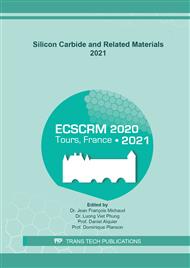p.330
p.335
p.341
p.346
p.351
p.356
p.361
p.366
p.371
Synchrotron X-Ray Topography Characterization of Power Electronic GaN Materials
Abstract:
Synchrotron X-ray topography techniques are used to characterize the microstructures in gallium nitride materials being developed for selective area doping for power electronic applications. Bulk substrates grown by different methods, epitaxial layers that are subject to ion implantation, annealing, etching and regrowth are characterized by X-ray topography in grazing incidence geometry and X-ray rocking curve topography. Strain and tilt maps of ion implanted epitaxial layers and etched and regrown wafers are generated. From the X-ray topographs, it is concluded that ammonothermal grown substrates show the highest quality among other types and most suitable for high-end electronic applications. It is also revealed that epitaxial growth, ion implantation and the annealing process do not change the dislocation distribution, but ion implantation introduces damage, strain and lattice bending effect, which are removed after annealing. Inductively coupled plasma (ICP) etching gives rise to strain variations in the wafer, while using tertiary butyl chloride (TBCl) to etch the wafer does not affect the strain distribution and can remove some damage from a preceding ICP etching process.
Info:
Periodical:
Pages:
351-355
Citation:
Online since:
May 2022
Permissions:
Share:
Citation:


